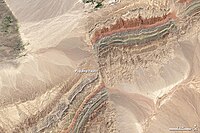
Photo from wikipedia
A Mw 7.2 earthquake struck the south flank of Kilauea, Hawaii, on 4 May 2018, following a period of volcanic unrest. To investigate its relationship with the stress changes induced… Click to show full abstract
A Mw 7.2 earthquake struck the south flank of Kilauea, Hawaii, on 4 May 2018, following a period of volcanic unrest. To investigate its relationship with the stress changes induced by prior tectonic and magmatic activity, we model the coseismic slip distribution, preintrusion deformation, and dike intrusion using geodetic, seismic, and tsunami observations. The décollement beneath the south flank was creeping seaward by ~25 cm/year. Diking started on 20 April and led to fissure eruption on 3 May. The magmatic activity and creep resulted in an onshore U‐shaped zone of stress unloading, fringed by an off‐shore zone of stress buildup that apparently guided the 2018 rupture. It takes only 20 to 35 years at the preintrusion rate to accumulate a moment deficit equivalent to the moment that was released in 2018. This event falls short of balancing the moment budget since the 1975 Mw 7.7 earthquake.
Journal Title: Geophysical Research Letters
Year Published: 2019
Link to full text (if available)
Share on Social Media: Sign Up to like & get
recommendations!